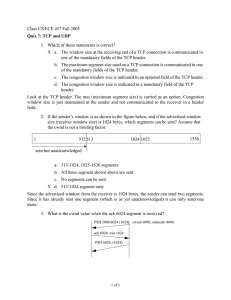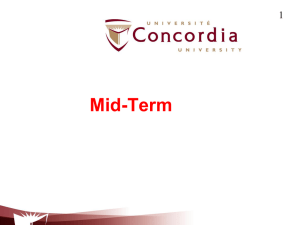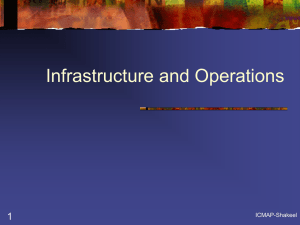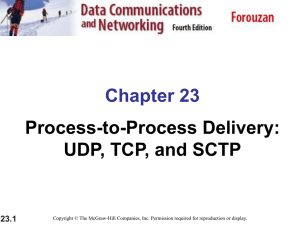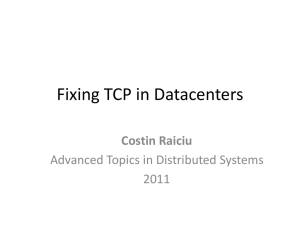Lapisan Transport (2)
advertisement
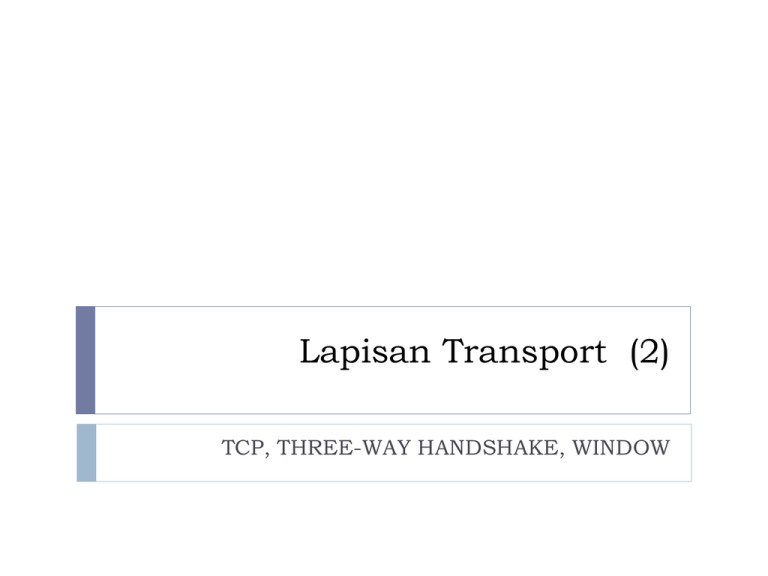
Lapisan Transport (2) TCP, THREE-WAY HANDSHAKE, WINDOW TCP • • • • TCP adalah protocol yang berorientasi pada koneksi (connectionoriented protocol); TCP akan membuat sebuat koneksi virtual antara dua komputer terlebih dahulu, sebelum keduanya saling bertukar data TCP mempunyai mekanisme flow dan error control Analogi : mengirimkan berita melalui telepon Topik diskusi : • TCP Services • • • • TCP Features Segment A TCP Connection Flow Control Error Control 23.2 Table 2 Well-known ports used by TCP 23.3 Figure 13 Pengiriman bytes stream 23.4 Figure 14 Sending and receiving buffers 23.5 Figure 15 TCP segments Note • • Segment yang ditransfer pada setiap koneksi akan diberi nomor (baca : sequence ID) oleh TCP. Penomoran dimulai dengan nomor yang dibangkitkan secara acak (relatif) Example 3 Dibawah ini adalah contoh penomoran pada setiap segment: Note Nilai sekuen mendefinisikan nomor byte data pertama yang terkandung pada segment Note • • Nilai dari koom acknowledgment pada segment, mendefinisikan nomor byte selanjutnya yang diharapkan akan diterima Nomor acknowledgment bersifat kumulatif. Figure 16 Format TCP segment 23.11 Figure 17 Control field 23.12 Table 3 Description of flags in the control field Figure 18 Connection establishment menunggakan three-way handshaking Note A SYN segment tidak dapat membawa data, tetapi membutuhkan 1 (satu) sequence number. Note A SYN + ACK segment tidak dapat membawa data, tetapi membutuhkan 1 (satu) sequence number. Note Sebuah ACK segment, apabila tidak dalam mebawa data, maka ACK tidak membutuhkan satu sequence number. Figure 19 Data transfer Figure 20 Connection termination using three-way handshaking 23.19 Note The FIN segment membutuhkan satu sequence number apabila tidak sedang membawa data Note The FIN + ACK segment consumes one sequence number if it does not carry data. 23.21 Figure 21 Half-close 23.22 Figure 22 Sliding window 23.23 Note A sliding window is used to make transmission more efficient as well as to control the flow of data so that the destination does not become overwhelmed with data. TCP sliding windows are byte-oriented. 23.24 Example 4 What is the value of the receiver window (rwnd) for host A if the receiver, host B, has a buffer size of 5000 bytes and 1000 bytes of received and unprocessed data? Solution The value of rwnd = 5000 − 1000 = 4000. Host B can receive only 4000 bytes of data before overflowing its buffer. Host B advertises this value in its next segment to A. 23.25 Example 5 What is the size of the window for host A if the value of rwnd is 3000 bytes and the value of cwnd is 3500 bytes? Solution The size of the window is the smaller of rwnd and cwnd, which is 3000 bytes. Example.6 Figure 23.23 shows an unrealistic example of a sliding window. The sender has sent bytes up to 202. We assume that cwnd is 20 (in reality this value is thousands of bytes). The receiver has sent an acknowledgment number of 200 with an rwnd of 9 bytes (in reality this value is thousands of bytes). The size of the sender window is the minimum of rwnd and cwnd, or 9 bytes. Bytes 200 to 202 are sent, but not acknowledged. Bytes 203 to 208 can be sent without worrying about acknowledgment. Bytes 209 and above cannot be sent. Figure 23 Example 23.6 Some points about TCP sliding windows: ❏ The size of the window is the lesser of rwnd and cwnd. ❏ The source does not have to send a full window’s worth of data. ❏ The window can be opened or closed by the receiver, but should not be shrunk. ❏ The destination can send an acknowledgment at any time as long as it does not result in a shrinking window. ❏ The receiver can temporarily shut down the window; the sender, however, can always send a segment of 1 byte after the window is shut down. ACK segments do not consume sequence numbers and are not acknowledged. Note In modern implementations, a retransmission occurs if the retransmission timer expires or three duplicate ACK segments have arrived. Note No retransmission timer is set for an ACK segment. Note Data may arrive out of order and be temporarily stored by the receiving TCP, but TCP guarantees that no out-of-order segment is delivered to the process. 23.33 Figure 24 Normal operation Figure 25 Lost segment 23.35 Note The receiver TCP delivers only ordered data to the process. Figure 26 Fast retransmission
